Great North Sea flood of 1953 remembered 70 years on
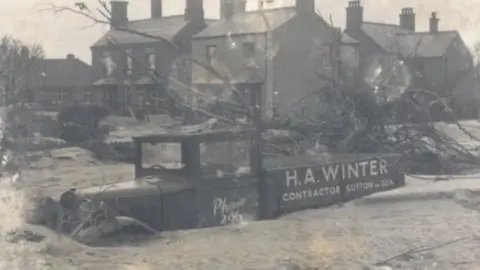 LRF Archive
LRF ArchiveOn the night of 31 January 1953, a wall of water surged from the North Sea, over-topping sea defences and leaving a trail of death and destruction in its wake.
A massive storm brought devastation to the east coast of England and claimed more than 300 lives, including 43 in Lincolnshire, 26 of whom were aged over 70.
It is widely regarded as one of the worst peacetime disasters to hit the country in the last century.
David Mitchell, who was aged 10 at the time, and lived on the Lincolnshire coast in Chapel St Leonards, said it caused "unbelievable havoc".
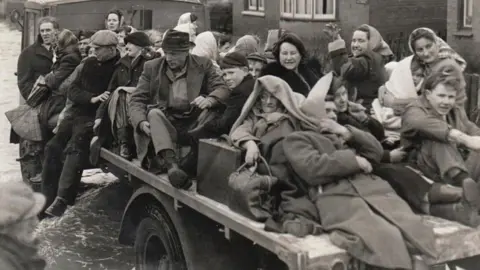 LRF Archive
LRF Archive LRF Archive
LRF ArchiveThe surge, which was caused by a combination of a high spring tide and severe winds, took everyone by surprise, Mr Mitchell said.
He recalls attending a birthday party in a local cafe when the owner asked the father of the boy celebrating: "Do you want your car?"
When he asked why, the cafe owner told him: "It's just gone floating past."
"The surge just engulfed everything," Mr Mitchell said.
 David Mitchell
David MitchellA Pathe News report from the time described how "acre upon acre and town upon town" between Lincolnshire and Kent had been engulfed.
There were reports of buildings collapsing, mountainous waves crashing through sea defences and people taking shelter on rooftops.
But amid the destruction, there were also tales of bravery.
A report in the London Gazette about Mr Mitchell's local bobby tells of his "competent handling of the desperate situation" and how, in one instance, he rescued an elderly bed-ridden couple using six 40-gallon tanks roped together to make an improvised raft.
Mr Mitchell, who is now 80 and lives in Lincoln, told BBC Radio Lincolnshire Constable Leonard Charles Deptford worked a 52-hour shift, and at one point waded past their home pulling a rowing boat.
"That was unusual as Chapel St Leonards isn't a fishing village, so we don't know where he got it from," he said.
Con Deptford, along with Insp Charles Lewis, from Mablethorpe, were both later awarded the George Medal in recognition of their bravery.
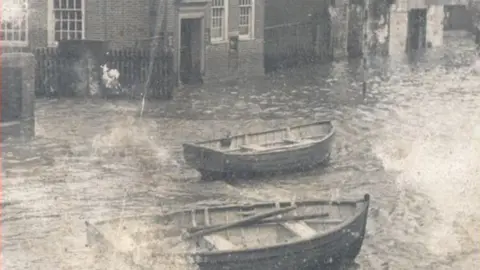 LRF Archive
LRF Archive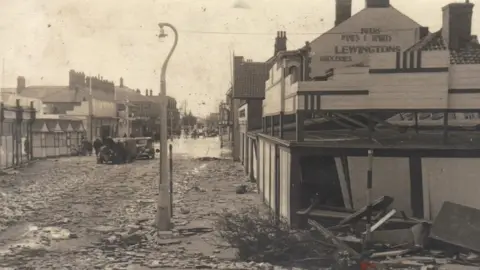 LRF Archive
LRF ArchiveThe surge also saw whole communities in Lincolnshire evacuated from their homes.
Mr Mitchell said he remembers being taken to Alford, about 8 miles (12.8km) away.
However, he says shortly after arriving he was moved again due to the floodwaters surging inland.
Although sea defences and communications had greatly improved in the years that followed, anyone who ignored the sea did so "at their peril", he added.
To commemorate the 70th anniversary of the floods, an archive of people's memories and photographs has been published by The Lincolnshire Resilience Forum (LRF).
In one account from 2010, Mablethorpe resident John Brown said his father had come home and said there was water coming up the High Street.
"The first thing we did was unplug the telly and carry it upstairs to the bedroom. At 20:45 the sea water was already 3ft deep. There was nothing to stop it."
According to the LRF, many of those caught up in the storm were not prepared for the severity of what was to unfold.
There was no national warning system and the weather forecast had not predicted it.
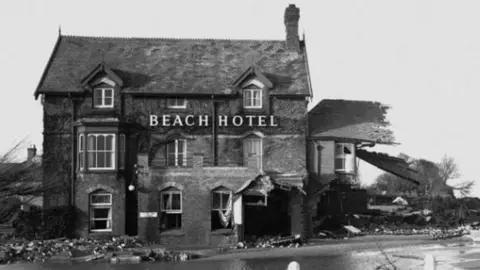 LRF Archive
LRF Archive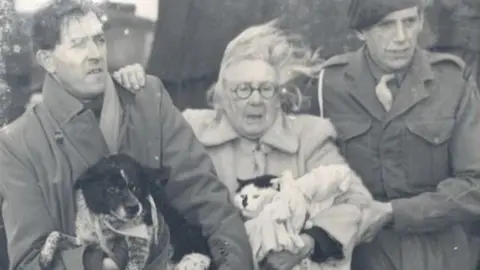 LRF Archive
LRF ArchiveIn Sutton-on-Sea, Bud Shields was walking back to the repair workshop, where he worked with his father, when he realised the tide was coming in earlier than expected.
In his archive interview, Mr Shields said: "I knew this was going to be something big."
He recalled how he went to help after hearing shouting nearby.
"I got hold of a ladder and whilst I was up this ladder... I saw part of the Beach Hotel against the darkness suddenly collapse.
"It was terrifying."
Sutton-on-Sea was one of the worst-affected areas in Lincolnshire, with 11 fatalities reported.
In her account, a young Barbara Spencer had been looking forward to a Saturday night trip to the cinema to see Gone with the Wind.
She said there was a knock at the door and it was a man saying: "Did you know the sea is coming over the bank?"
"We knew this sort of thing happened every year when the weather was rough, but when we went to leave and opened the door, the sea rushed past," she said.
"We immediately started to take what we could upstairs."
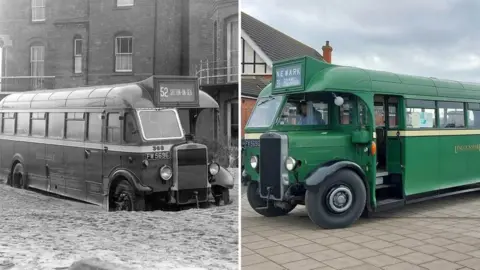 Archive/David Monk
Archive/David Monk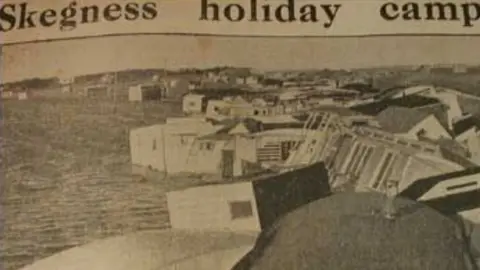 LRF Archive
LRF ArchiveElsewhere, events have been taking place to mark the anniversary.
In Sutton-on-Sea, a 1935 Leyland Tiger bus, left stranded after it was engulfed by the sea, has been on public display as part of an exhibition.
Owner John Marshall said: "We know for a fact the bus was near the promenade when the sea wall broke and it was flooded to a depth of almost 5ft.
"The passengers were very lucky to get out."

Analysis by Paul Hudson, BBC Look North weather presenter and climate correspondent
The North Sea is no stranger to disasters. One of the greatest on record, the St Elizabeth Flood of November 1421, cost 10,000 lives on the Dutch coast as 70 villages were submerged.
The disaster of 1953 was caused by a coming together of three events. Storm-force northerly winds coincided with an exceptionally high spring tide, which moved southwards down the North Sea, with the intense area of low pressure which brought the stormy conditions causing the surface of the sea water to rise. This created a huge tidal surge, which happened in the middle of the night while most people were asleep.
The government in the wake of this terrible flood set up the Waverley Committee which discovered that the Met Office, responsible for weather information, and the Hydrographic department, which calculated the tidal information, did not collaborate. It was this lack of communication, the report determined, which made the loss of life much greater.
Climate change means that coastal floods like these are likely to become more frequent and intense, but lessons have been learnt since 1953, and the Met Office now has a dedicated storm tide service, meaning such loss of life is highly unlikely in any future event.

After 1953, sea walls and defences were built and strengthened.
However, parts of the east coast were again hit by a tidal surge in 2013.
In Boston, which is now protected by a floodgate, the River Haven burst its banks and sent water rushing through more than 50 streets in the town.
Martin Hill, leader of Lincolnshire County Council, said the events of 1953 "remind us that we cannot be complacent".
However, he said the county was now much better prepared.
A remembrance service is taking place at St Peter and St Paul Church in Ingoldmells later.
Exhibitions are also taking place in Mablethorpe and at the North Sea Observatory in Chapel St Leonards.

Follow BBC Yorkshire on Facebook, Twitter and Instagram. Send your story ideas to [email protected].
